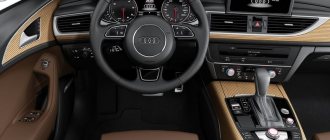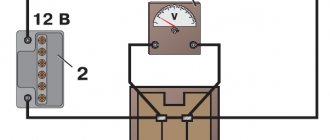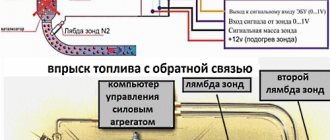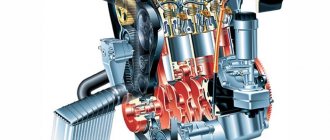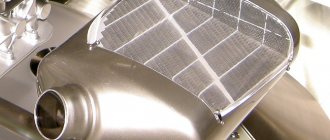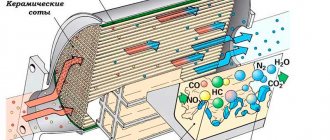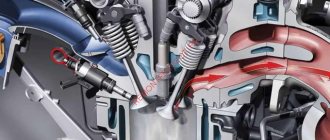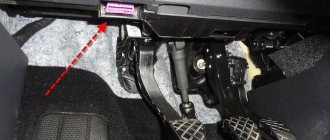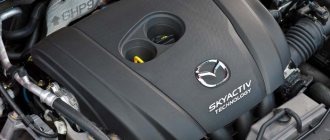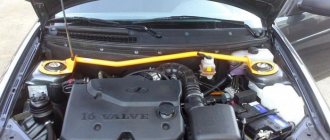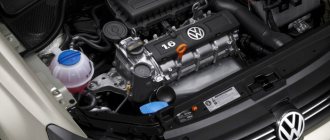All generations of Audi A6
2019 – today
C8
2015 – 2018
C7 rest.
2012 – 2015
C7
2008 – 2012
C6 rest.
2006 – 2008
C6
2001 – 2004
C5 rest.
1998 – 2001
C5
1994 – 1997
C4
Fast passage
- A Acura
- Alfa Romeo
- Alpina
- Alpine
- Aston Martin
- Audi
- Aurus
- B Bajaj
- Bentley
- BMW
- Brilliance
- Bugatti
- BYD
- C Cadillac
- Caterham
- Changan
- Chery
- Chevrolet
- Chrysler
- Citroen
- Daewoo
- Daihatsu
- Dartz Motors
- Datsun
- Detroit Electric
- DFM
- Dodge
- FFAW
- Ferrari
- Fiat
- Ford
- Foton
- G GAC
- GAZ
- Geely
- GMC
- Great Wall
- GTA Motor
- H Hafei
- Haima
- Haval
- Hawtai
- Hennessey
- Honda
- Hummer
- Hyundai
- I Icon
- Infiniti
- Iran Khodro
- Isuzu
- JJAC
- Jaguar
- Jeep
- K KIA
- Koenigsegg
- L Lada
- Lamborghini
- Land Rover
- Lexus
- LIFAN
- Lincoln
- Lotus
- Luxgen
- M Marussia
- Maserati
- Maybach
- Mazda
- Mazzanti
- McLaren
- Mercedes-Benz
- MG Cars
- MINI
- Mitsubishi
- N Nissan
- Opel
- P Pagani
- Peugeot
- PGO
- Porsche
- Proton
- Q Qoros
- Ravon
- Renault
- Rolls-Royce
- S Saab
- Samsung
- SEAT
- SeAZ
- Skoda
- Smart
- SsangYong
- Subaru
- Suzuki
- T TagAZ
- Tata
Go
The new Audi A6 2011 model year was presented to potential buyers in early December 2010, when official photographs and characteristics of the 4th generation sedan first appeared in automobile magazines and the Internet. Compared to the previous generation, which was produced since 2004 and underwent one restyling in 2008, the exterior, interior and technical characteristics of the car were updated. In particular, the 2011 Audi A6 received new headlights with running lights and taillights, in which LEDs replaced traditional lamps. The outlines of the front bumper and false radiator grille have changed, and an integrated spoiler has appeared at the rear, which serves as a continuation of the trunk lid. And, despite the fact that the new Audi A6 2011 has grown in size, its weight has decreased by approximately 80 kg. The Audi engineering team was able to lighten the car due to the fact that about 20% of the body panels and suspension components are made of aluminum. The dynamic characteristics of the Audi A6 2011 are determined by 5 power units: 2 gasoline and 3 diesel, but cars supplied to the Russian market are equipped with only three. These are 2 petrol engines of the TSFI line. The first one, volume 2 liters. and a power of 180 hp, is combined with a 6-speed manual or Multitronic automatic transmission, and the second is a 300-horsepower V6 with a volume of 3 liters. And finally, the third is a 3-liter diesel engine with a power of 245 hp. Thus, the power of the power units has remained the same since the previous generation, excluding the 2.0 TSFI, which added 10 hp, but average fuel consumption, according to official data, decreased by 13-16%. In addition to two top-end engines, the new 2011 Audi A6 is equipped with an S Tronic robot and Quattro all-wheel drive with a sports rear differential and dynamic traction distribution along the axles. Another distinctive feature of the 2011 Audi A6 is the Drive Select system, which is available as standard and allows you to select one of 5 driving modes. Each has its own settings for the electromechanical power steering, engine and transmission. In turn, the adaptive air suspension allows you to adjust the vehicle's ground clearance and the stiffness of the shock absorbers.
The debut of the third generation of the 2012 Audi A6 Allroad Quattro took place at the Detroit Auto Show. Like all its predecessors, the model is based on the A6 Avant station wagon, the ground clearance of which has increased by 60 mm, and the appearance has changed thanks to the traditional protective body kit made of black plastic. Along with this, the 2012 Audi A6 Allroad received additional underbody protection at the front and rear, and the exterior underwent the same changes that affected other Audi cars of the 2012 model year.
The main difference from the “junior” A4 all-terrain vehicle is that the new Audi A6 Allroad Quattro is equipped with adaptive air suspension. At high speeds, it automatically lowers the ride height by 15 mm, and when driving on poorly surfaced roads, the body can be raised by 35 mm at the touch of a button. Additional comfort for the driver of the 2012 Audi A6 Allroad is designed to be provided by the proprietary Drive Select system, which optimizes the operation of the engine, electromechanical power steering, suspension and other systems in accordance with the driving mode.
The Audi A6 Allroad 2012 model year is equipped with two 3-liter V6s: a petrol TSFI, developing 310 hp. and 440 Nm of torque, as well as a turbodiesel with a power of 245 hp. and a torque of 580 Nm. In addition to both engines, customers are offered an all-wheel drive transmission with a 7-speed S-Tronic robotic gearbox. The new Audi A6 Allroad Quattro accelerates from 0 to 100 km/h in just 5.9 seconds with a petrol engine, and in 6.6 seconds with a diesel engine.
The list of standard equipment of the Audi A6 Allroad 2012 includes a start-stop system, an energy recovery system during braking and coasting, 4 airbags, a parking radar with sensors on both bumpers, xenon headlights and the MMI Radio plus system. Among the most interesting and useful options are adaptive cruise control, which can prevent accidents at speeds of up to 30 km/h, an assistant for changing lanes and maintaining a lane, as well as adaptive headlights. In addition, buyers of the 2012 Audi A6 Allroad can equip the car with a navigation system and Bang & Olufsen acoustics.
Causes of malfunction
The fact is that incorrect signals regarding the voltage of the gas pedal position sensor are transmitted to the engine control unit or none at all. This occurs due to the existing contact resistance. But since there are no other components connected to the wires from the accelerator pedal position sensor to the engine control unit, the causes of this problem may be the following:
- Incorrectly connected connector of the gas pedal module and switching unit, as well as the engine control unit.
- Ingress of moisture and/or oxidation of contacts, which causes transient resistance. The culprit for this is a leaky switching unit.
- Damage to the wiring between the gas pedal module and the engine control unit.
- Poor connection of the ground contact of the engine control unit with the body ground or its absence,
- Other 5-volt sensors that are connected to the same power source as the accelerator pedal module that caused the error.
- Damaged engine control unit.
- And of course, damage to the gas pedal position sensor.
From my own experience, I would like to note that the error under point 2 most often occurs. In this case, you should replace the leaky switching unit and erase the error from the engine control unit. You need to know that the engine control unit, even after a short-term loss of the gas pedal position signal, switches to an emergency operating program for safety reasons. As a result, there is an increase in idle speed and a significant decrease in engine power.
Well, now let's start checking.
Technical specifications of the Audi A6 generation C7
station wagon
Average car
- width 1,874mm
- length 4,926mm
- height 1,461mm
- ground clearance???
- seats 5
| Engine | Fuel | Drive unit | Consumption | Up to a hundred | Max. speed |
| 2.0 TDI CVT (177 hp) | DT | Front | 4,5 / 6,1 | 8.5 s | 216 km/h |
| 3.0 TDI quattro AMT (245 hp) | DT | Full | 5,2 / 7,2 | 6.3 s | 243 km/h |
| 3.0 TFSI quattro AMT (300 hp) | AI-95 | Full | 6,6 / 10,8 | 5.6 s | 250 km/h |
sedan
Average car
- width 1,898mm
- length 4 940mm
- height 1,512mm
- ground clearance???
- seats 5
| Engine | Fuel | Drive unit | Consumption | Up to a hundred | Max. speed |
| 2.0 TDI MT (177 hp) | AI-95 | Front | 8.2 s | ||
| 2.0 TFSI MT (180 hp) | AI-95 | Front | 8.1 s | ||
| 2.0 TFSI CVT (180 hp) | AI-95 | Front | 8.3 s | ||
| 2.8 FSI CVT (204 hp) | AI-95 | Front | 7.7 s | ||
| 2.8 FSI quattro AMT (204 hp) | AI-95 | Full | 8.1 s | ||
| 2.0 TFSI Hybrid AT (245 hp) | AI-95 | Front | 7.5 s | ||
| 3.0 TDI quattro AMT (245 hp) | DT | Full | 6.1 s | ||
| 3.0 TFSI quattro AMT (300 hp) | AI-95 | Full | 5.5 s | ||
| 3.0 TFSI quattro AMT (310 hp) | AI-95 | Full | 7,1 / 11,8 | 5.9 s | 250 km/h |
Looking for Audi A6 reviews? View reviews of the Audi A6
Fuse and relay box in the trunk of an Audi A6 C7
It is located on the right side of the trunk, under the mesh pocket. To gain access, remove the casing block.
Description of fuse diagram
| Fuse box -A- (black) | ||
| № | Consumer | Ampere |
| 1 | Towbar | 15 |
| 2 | Tow bar/ heated cup holder | 20/10 |
| 3 | Tow bar/rear seat adjustment switch | 20/5 |
| 4 | Electromechanical parking brake | 30 |
| 5 | Electromechanical parking brake | 30 |
| 6 | Front door (front passenger side) | 35 |
| 7 | Exterior lighting at the rear of the vehicle | 30 |
| 8 | Rear curtain, adjustment device, trunk door lock, chip key, START ENGINE STOP, refueling hatch cover | 20 |
| 9 | Electric seat adjustment | 15 |
| 10 | Parking assistance system | 5 |
| 11 | Heated seats (rear) | 30 |
| 12 | Towbar | 25 |
| Fuse box -B- (red) | ||
| № | Consumer | Ampere |
| 1 | Left seat belt tensioners | 25 |
| 2 | Right seat belt tensioners | 25 |
| 3 | Socket | 20 |
| 4 | Socket | 20 |
| 5 | Electromechanical parking brake | 5 |
| 6 | Air suspension | 15 |
| 7 | Rear door (front passenger side) | 35 |
| 8 | Exterior lighting at the rear of the vehicle | 30 |
| 9 | Trunk door control unit | 30 |
| 10 | Telephone | 5 |
| 11 | Amplifier | 30 |
| 12 | Rear spoiler | 20 |
| Fuse box -C- (brown) | ||
| № | Consumer | Ampere |
| 1 | Radio receiver, audio amplifier/front center console MMI | 30/20 |
| 2 | Tank leak detection system | 5 |
| 4 | AEM control unit/battery module | 15/7,5 |
| 6 | Battery fan | 35 |
| 7 | Radio receiver | 7,5 |
| 8 | Rear Seat Entertainment System | 7,5 |
| 9 | Automatically screened interior rearview mirror/battery module | 5/15 |
| 10 | Parking assistance system | 5 |
| 11 | TV tuner | 5 |
| Fuse box -D- (green) | ||
| № | Consumer | Ampere |
| 1 | Audi pre sense system | 5 |
| 2 | Electromechanical parking brake | 5 |
| 3 | Air suspension | 5 |
| 4 | Clutch travel sensor/automatic transmission | 5/7,5 |
| 5 | Parking assistance system | 5 |
| 6 | Rear Seat Entertainment System | 5 |
| 7 | Start/Stop system | 5 |
| 8 | "Audi side assist" | 5 |
| 9 | "Gateway", control unit 1 (on-board network) | 5 |
| 10 | Sports differential | 5 |
| 11 | Rear wiper | 7,5 |
What car enthusiasts say about Audi A6 automatic transmission repair
- Symptoms of a problem “I’ll tell you my story. Six months ago I bought myself a used Audi with a mileage of 96 thousand km and drove it for some time without any problems. The automatic transmission did not cause any complaints. The adventure began when the mileage reached 121 thousand...
Once, having sharply accelerated while overtaking from 130 km/h and then lowered the gear, after a couple of seconds I felt a fairly strong blow in the area of the automatic transmission. On the next overtaking the same situation occurred. Later I overtook more carefully, because I was seriously afraid for the box. And it seemed like the machine didn’t give out any more such surprises.But a couple of days later a more serious malfunction occurred that required repairs. I was driving the Audi already in the city. During sudden lane changes in 5th gear, the transmission switched to emergency mode in about half of the cases, instead of normally shifting to a lower gear. To do this, I only had to press the gas pedal a third or half of its travel.
It turned out that the oil pump was faulty. It had to be changed. Also, the entire set of brass bushings was replaced, since play had formed on the axles. And, of course, I sent the torque converter for repair.”
- Cost of breakdown
“In my case, replacing the automatic transmission solenoids helped. I also changed the transmission fluid, although this could not have been done. In the end, I ended up with 20,000 rubles. When the cost of the box is around 150 thousand, I don’t see any point in spending more on repairs.” - Technologies .
- Cost of repairs and spare parts
“The cost of the MaasterKit automatic transmission repair kit from ZF is approximately 25,000 rubles. The kit includes clutches, seals, o-rings, gasket, steel discs and filter. Transmission fluid from Mobile will cost about 3,000 rubles, and repairing the torque converter will cost about 8,000. Next: removing and installing the automatic transmission - about 8,000 rubles, disassembling and assembling the transmission - another 10-12 thousand. In total, we get a cost of around 56 thousand rubles.
Signs of malfunction of the Audi A6 C5 and C6 CVT
The most common cause of CVT malfunction begins with wear of the cone bearings, which causes a characteristic hum to be heard. Bearing noise occurs due to wear products getting onto their working surfaces, as a result of which they become unusable. Special oil filters retain the metal suspension for the time being.
Thus, timely maintenance of the bearings or replacing them with the necessary spare parts will prevent more serious problems with the variator.
The next reason that can cause problems with the variator is jerking and twitching of the vehicle, which occurs due to the jamming of the oil pump pressure relief valve. The same harmful wear products interfere with the normal operation of this unit, disrupting the stable pressure in the system.
A timely visit to a specialized workshop will help you avoid larger repair costs. Minor damage to the bevel pulleys can be repaired by grinding, but the belt will most likely have to be replaced.
Quite rare malfunctions that precede the breakdown of the variator include failure of the torque converter, as well as failures in the electronics caused by breakdowns of some elements of the control unit. However, this kind of malfunction occurs quite rarely and is not a pattern, but rather a factor of bad luck.
